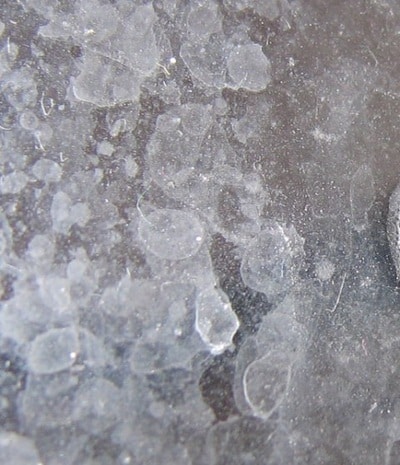With our blog today, our goal is to help settle some of the confusion surrounding soap scum, what it is, where it comes from and what to do about it. Having studied chemistry in college, understanding chemical reactions has always interested me. Probably explains why I am a soap-making nerd and Star Trek fan.
As we speak with customers, we run into people who blame their soap scum directly on and only on “bar” soap. They have decided they will only use “gels” or “liquids”, believing this will solve the problem. In reality, the amount of soap scum you experience in your tubs or sinks is directly related to your water supply. Commercial shower gels typically do not leave soap scum because they are not SOAP, they are chemically laden detergents. Remember, your skin can absorb over 50% of the ingredients it comes into contact with. Detergent based soaps are not skin friendly. Most detergent based products do not create soap scum because they do not react with calcium and magnesium ions found in hard water.
So, what is soap scum and what causes soap scum? Soap scum is comprised of dirt and oils, but most importantly……minerals.
Here is how soap scum happens:
As the water in the atmosphere condenses, it dissolves carbon dioxide from the air, forming a weaker carbonic acid. This acidic rainwater eventually falls to the earth and then percolates through the soil to the bedrock, often limestone. Limestone is composed of calcium and magnesium carbonate. The acid dissolves the lime, then the calcium and magnesium ions become part of the water supply.
When hard water mixes with dirt, body oils, and soap residue, the result is soap scum. If allowed to build up over time, the deposits can harden and become very difficult to remove. A water softener installed in the home is only one solution.
Let’s not pretend here, it comes down to what is more important to the consumer. Personally, we prefer products are that skin healthy and will deal with a little soap scum in our house cleaning routine. It doesn’t have to be a dreaded chore and there are several natural ways to remove scum provided it has not been allowed to build for too long.
Natural Ways to Remove Soap Scum
Baking Soda And Lemon Combo
The acidic quality of lemons breaks down soap scum buildup naturally with citric acid. This makes lemons a great natural cleanser. In addition, baking soda is slightly abrasive, but still gentle enough that it won’t scratch or damage the surface. Baking soda is a natural deodorizer as well, and keeps bathrooms fresh.
To remove scum naturally, gather ½ cup of baking soda and 1/2 of a lemon. Rub the lemon on the fixtures. Follow this with a damp washcloth sprinkled with baking soda and rub the fixture. If the buildup is substantial and has been there a long time, it may take a lot of scrubbing to remove it.
White Vinegar
To help prevent the buildup between normal cleanings, a diluted solution of vinegar is a wonderful preventative.
Simply make a 25% dilute solution of white vinegar and distilled water and keep in a spray bottle. After your shower, spray the shower/tub with the solution.
A Tip on Cleaning Clear Shower Doors
We love crystal clean shower doors, but we also know what can happen if matched with hard water…… dingy, cloudy, uninviting glass panels! Channel your inner scientist by mixing one-half a cup of baking soda and just enough white vinegar to create a pasty mixture. YES…..fizzing and bubbling will result, but don’t worry, you have only created safe carbon dioxide (CO2). After it fizzes off, you are left with a dilute solution of sodium acetate and water, ready for your shower doors!
Use a sponge and apply the paste to your shower doors. Let sit for 10 – 15 minutes. Use scrubbing sponge (the type that does not scratch) and scrub the door gently and rinse. That should do it.


